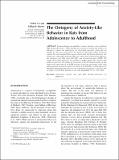The ontogeny of anxiety-like behavior in rats from adolescence to adulthood
Abstract
In human beings, susceptibility to anxiety disorders can be relatively high during adolescence. Understanding the ontogeny of anxiety-like behavior in laboratory rodents has implications for developing anxiolytic drugs that are suitable for this age group. Given the dearth of information about adolescent rodents, this study examined the response of both male and female adolescent, late adolescent, young adult, and older adult rats to three tests of anxiety-like behavior: the emergence test (ET), open field (OF), and elevated plus-maze (EPM). The results showed that adolescent rats exhibited a higher anxiety-like response than adults on each test; the amount of locomotion in the OF and percentage of time spent on the open arms of the EPM increased across the age groups, while older adult rats made the fewest start box re-entries in the ET. These results support the hypothesis that adolescent rats have a more pronounced response to stressors than do adults. © 2010 Wiley Periodicals, Inc. Dev Psychobiol 52: 731–739, 2010.
Citation
Lynn , D A & Brown , G R 2010 , ' The ontogeny of anxiety-like behavior in rats from adolescence to adulthood ' , Developmental Psychobiology , vol. 52 , no. 8 , pp. 731-739 . https://doi.org/10.1002/dev.20468
Publication
Developmental Psychobiology
Status
Peer reviewed
ISSN
0012-1630Type
Journal article
Description
Funding provided for Gillian Brown by Wellcome Trust grant 078405/Z/05/ZCollections
Items in the St Andrews Research Repository are protected by copyright, with all rights reserved, unless otherwise indicated.

